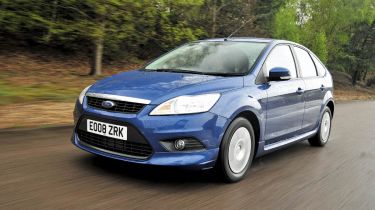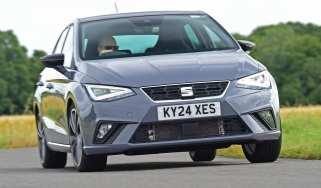Ford Focus 1.6 TDCi ECOnetic
Is hatch best-seller an even stronger proposition with eco changes?
The three letters that have always meant most to hatchback drivers have long been G, T and I. But could they soon be replaced by E, C and O? The newest arrival on the green scene aims to show that we can have the best of both worlds, merging one of the finest-handling chassis in the compact family class with guilt-free emissions. So how much of the standard Focus’s shine has been lost in the transition from hot hatch to eco warrior?
It’s easy to spot Ford’s ECOnetic model – it’s one of the few new Focuses you will ever see without alloys. And while the hubcaps look old-fashioned, they help reduce the drag factor.
Other design tweaks include unique front and rear bumpers and low side skirts, and it all helps the Ford slip through the air using the minimum possible power. Low-viscosity transmission oil also does its bit to reduce wasteful energy losses.
But there’s another reason for making the Focus stand out. One of the key factors in the success of Toyota’s Prius has been the statement it makes about the driver – it attracts buyers who want to be seen to be green. By giving the Focus ECOnetic a different look from other cars in the range, Ford can also appeal to this mindset.
Inside, we’re not sure about the seaside deckchair seat trim, but otherwise the cabin features the same high-quality and well built dash as fitted to all versions of the facelifted Focus. The only real difference is the trip computer between the speedo and rev counter, which often displays sky-high mpg figures.
Ford claims economy of 65.6mpg, although even the standard 1.6 TDCi promises 62.7mpg. In our hands, it returned 45.8mpg. But no matter how much diesel it drinks, the ECOnetic sets itself apart with its CO2 emissions. It shaves 3.5 per cent off the oil-burner’s output, with a 115g/km figure.
This not only places the Focus in tax band B – leading to annual road tax of just £35 – but will also make it free to drive in central London under the proposed changes to the congestion charge.
In terms of dynamics, there’s little to separate the ECOnetic from the normal Focus. The superb balance of comfort and handling is largely carried over. Only the skinny low-rolling-resistance tyres, which are made from a harder compound than the standard rubber, take the edge off, as they provide less grip when cornering.
The ride also seems firmer, but that aside the ECOnetic is surefooted, with responsive steering and good body control. Ford can be proud that the car still has road-holding abilities which put many rivals to shame on the grippiest of tyres.
Performance is surprisingly punchy, with the refined four-cylinder turbocharged engine rarely feeling underpowered. However, drivers doing lots of motorway miles will miss the sixth ratio that more potent Ford TDCis use to great effect for relaxed cruising. It’s clear that the new model demands few compromises over more polluting versions of the Focus then. So, the big question is why anyone would not choose the ECOnetic – especially when the price difference is so small.
The low-CO2 Ford costs £16,550 as a five-door, or £17,400 if you want the estate variant. That means the hatchback is only around £250 more expensive than the five-door Style model equipped with the same 108bhp TDCi engine. A lower-powered 89bhp variant is also available, but the gains in emissions and fuel economy on this car are minimal.
In reality nearly all the benefits offered by the ECOnetic Focus can be reaped with the cheaper standard TDCi. But if you must have the greenest of Fords, the newcomer won’t disappoint.
Details
Price: £16,550
Model tested: Focus 1.6 TDCi ECOnetic







